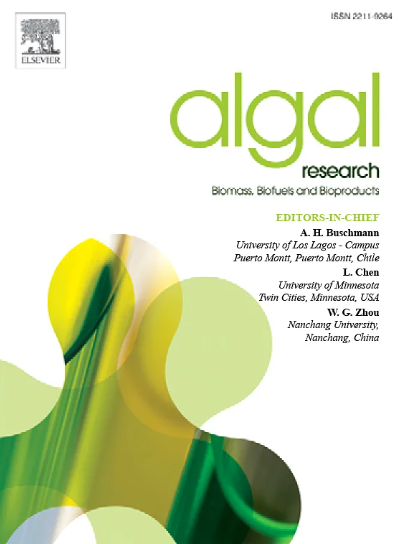Natural pigments from micro- and macro-algae for nail polish application
IF 4.6
2区 生物学
Q1 BIOTECHNOLOGY & APPLIED MICROBIOLOGY
Algal Research-Biomass Biofuels and Bioproducts
Pub Date : 2025-02-28
DOI:10.1016/j.algal.2025.103983
引用次数: 0
Abstract
Growing concerns about environmental sustainability and the health risks associated with synthetic pigments have fueled a surge in demand for natural alternatives, particularly in the cosmetics industry. This study explores the feasibility of using pigments derived from both microalgae and macroalgae in nail polish formulations, focusing on their pigment profiles, stability, and practical possibilities. Pigments from Chlorella sp., Spirulina sp., Undaria sp., and Caulerpa sp. were investigated as potential sources. The extraction process employed solvent-based methods, with characterization carried out using UV–visible spectroscopy, ATR-FTIR, and 1H NMR techniques to identify their compositions, including chlorophylls and carotenoids. The extracted pigments exhibited a diverse palette of colors: Chlorella sp. produced a yellowish-green, Spirulina sp. produced dark green, Undaria sp. produced a brownish-green, and Caulerpa sp. produced a light green-yellow. Chlorella sp. and Spirulina sp. exhibited chlorophyll a concentrations of 51.92 ± 15.16 μg/mL and 134.46 ± 21.68 μg/mL, respectively, while Undaria sp. demonstrated the highest concentrations of chlorophyll a (148.23 ± 16.56 μg/mL). However, Caulerpa sp. revealed the lowest chlorophyll a concentration of 14.72 ± 4.77 μg/mL. The analysis revealed that chlorophyll a was the predominant pigment across all species, while carotenoids contributed to the diversity of hues. Stability tests showed films incorporating pigments from Undaria sp. retained over 90 % of their original color over 21 days at 45 °C, outperforming those with Chlorella sp. and Caulerpa sp., which displayed noticeable degradation. These findings demonstrate the potential of algae-derived pigments as sustainable, long-term, and non-toxic alternatives to synthetic pigments in cosmetic applications. However, challenges remain in terms of pigment stability and extraction process scalability, both of which require formulation strategies to improve long-term performance in commercial applications.

求助全文
约1分钟内获得全文
求助全文
来源期刊

Algal Research-Biomass Biofuels and Bioproducts
BIOTECHNOLOGY & APPLIED MICROBIOLOGY-
CiteScore
9.40
自引率
7.80%
发文量
332
期刊介绍:
Algal Research is an international phycology journal covering all areas of emerging technologies in algae biology, biomass production, cultivation, harvesting, extraction, bioproducts, biorefinery, engineering, and econometrics. Algae is defined to include cyanobacteria, microalgae, and protists and symbionts of interest in biotechnology. The journal publishes original research and reviews for the following scope: algal biology, including but not exclusive to: phylogeny, biodiversity, molecular traits, metabolic regulation, and genetic engineering, algal cultivation, e.g. phototrophic systems, heterotrophic systems, and mixotrophic systems, algal harvesting and extraction systems, biotechnology to convert algal biomass and components into biofuels and bioproducts, e.g., nutraceuticals, pharmaceuticals, animal feed, plastics, etc. algal products and their economic assessment
 求助内容:
求助内容: 应助结果提醒方式:
应助结果提醒方式:


